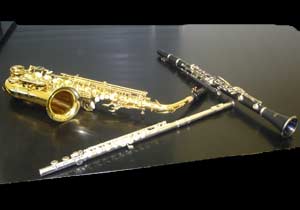|
Music 257A
Spring Semester, 2009 T/Th, 1:30-2:30 p.m. Craig Hall 113 R. Duhaime The purpose of the course is to provide both practical and theoretical information relating to the pedagogy and performance of single-reed instruments. Students will learn the similarities and differences of the standard single-reed woodwinds while beginning to develop the physical techniques required to play two of the instruments. Equally important will be the acquisition of pedagogical skills necessary for teaching the instruments to others, including a survey and critique of some of the standard literature for each instrument. Texts: Two current band method books, supplied in class: One text required (all recommended), available through Eble
Music Company: (319) 338-0313 Various handouts, texts, and method books to be supplied. Class Attendance: Because a significant portion of the final grade for the course will be based on daily performance and participation, as noted below, attendance at all class sessions is expected, with any missed sessions requiring immediate arrangements to be made before the next class session. Grading: A+/A/A- final average from
100%-90%; history required for A+ The final averages will be computed from the
following: Honor System: The current Honor System employed by Austin College (see posted statements) is in full effect for the course, particularly regarding critiques, class presentations, and exams.
Instrument Histories and Methods Critiques Instrument History (due March 14; bibliography due no later than March 2): Prepare a brief (4-6 pp.) paper which covers the history, development, and use of one instrument and present a synopsis of your findings in an oral report to the class. (Copies of the history should be made for everyone.) For flute (flûte traversière, Querflöte, flauto traverso) and clarinet, begin with the immediate predecessors of the modern instruments (18th century); for saxophone, begin with the experiments which lead to the modern instrument (ca. 1840). A least four independent sources must be used, only one of which may be of an encyclopedic format. Required for final grade of A+. Recommended starting places to compile a bibliography include: Baines, Anthony. Woodwind Instruments and Their History. New York: Dover, 1991. Sadie, Stanley, ed. The New Grove Dictionary of Music and Musicians. 2nd ed. New York: Groves Dictionaries, c2001. Methods Critiques (for class presentation weekly during the weeks March 28 through May 4): Using the given criteria as a guideline, prepare a written critique (with copies to each class member) and a brief oral summary of each of the methods for your instrument given below. All materials are available from the instructor and must be returned immediately after examination. Flute
Clarinet
Saxophone
Criteria for Method Book Critiques Cite author, title, publisher, date of publication, number of pages, approximate cost. Indicate the level for which the book was written: age/grade Note the quality of materials (particularly the cover) of the text. Are instrument assembly, care, and maintenance covered accurately and effectively for the target student? Are the essentials of embouchure, posture, finger and hand position, tonguing, and breathing covered (with clear photographs and/or drawings) correctly, logically, and in appropriate terms for the target student? Is the music well edited with breath marks, reminders of proper posture, hand position, etc.? Check the accuracy and ease of use of the fingering chart and if alternate (trill) fingerings are given with appropriate examples for use. Is a list of general music terms included? Note the legibility of the notation. Is adequate space given for additional markings by the teacher? Does the text contain excessive explanations, reminders, etc., to the extent that it has a “cluttered” appearance? Are the concepts of rhythm and time (and their notation) explained (and reinforced) successfully? Are dynamics introduced and used in the lessons which follow their introduction? Does the text introduce ensembles (duets, trios), or is ensemble playing neglected? Are both the language and the music used appealing for the target student, or are they outdated, dry, dull? Examine the first few lessons. Do they comprise a logical follow-up to the previous book in a series? (If the book be a beginning text, would the first lessons be a successful way to start a student?) For flute: Are the similarities and differences between the octave fingerings explained correctly? Is the means to produce the octaves explained correctly and effectively? Are tuning and intonation covered? Is vibrato covered? For clarinet: Are the explanations and exercises for introducing “the break” correct and effective? Is the second break covered? Are tuning and intonation covered? Are reeds discussed? For
saxophone: Are the explanations and exercises for introducing the
octave key Does the text progress too quickly or neglect specific skills, such as staccato tonguing, more advanced rhythms (especially in compound meters), which are within the scope of the text? In summary: Is the scope of the text covered by its contents? Is there a logical, realistic progression which builds from the first to the last page in a consistent, coherent manner, or would major editing changes be needed to make the text useful or valuable? If changes be needed, is the text still of value?
Topical Reading Assignments
|
|||||||||||||

